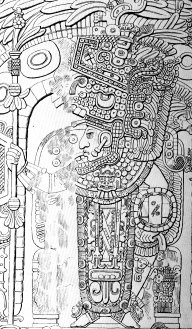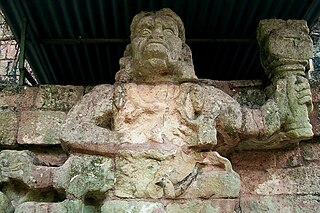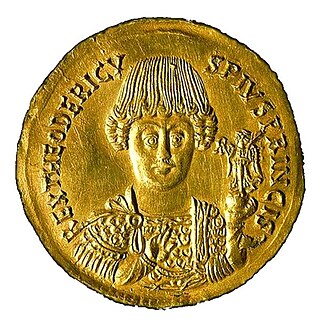
Theodoricthe Great, also called Theodoric the Amal, was king of the Ostrogoths (471–526), and ruler of the independent Ostrogothic Kingdom of Italy between 493 and 526, regent of the Visigoths (511–526), and a patrician of the Eastern Roman Empire. As ruler of the combined Gothic realms, Theodoric controlled an empire stretching from the Atlantic Ocean to the Adriatic Sea. Though Theodoric himself only used the title 'king' (rex), some scholars characterize him as a Western Roman Emperor in all but name, since he ruled large parts of the former Western Roman Empire, had received the former Western imperial regalia from Constantinople in 497, and was referred to by the title augustus by some of his subjects.
The 500s decade ran from January 1, 500, to December 31, 509.

Year 628 (DCXXVIII) was a leap year starting on Friday of the Julian calendar. The denomination 628 for this year has been used since the early medieval period, when the Anno Domini calendar era became the prevalent method in Europe for naming years.

Year 458 (CDLVIII) was a common year starting on Wednesday of the Julian calendar. At the time, it was known as the Year of the Consulship of Maiorianus and Leo. The denomination 458 for this year has been used since the early medieval period, when the Anno Domini calendar era became the prevalent method in Europe for naming years.
Year 490 (CDXC) was a common year starting on Monday of the Julian calendar. At the time, it was known as the Year of the Consulship of Faustus and Longinus. The denomination 490 for this year has been used since the early medieval period, when the Anno Domini calendar era became the prevalent method in Europe for naming years.

Year 507 (DVII) was a common year starting on Monday of the Julian calendar. At the time, it was known as the Year of the Consulship of Anastasius and Venantius. The denomination 507 for this year has been used since the early medieval period, when the Anno Domini calendar era became the prevalent method in Europe for naming years.

Year 508 (DVIII) was a leap year starting on Tuesday of the Julian calendar. In the Roman Empire, it was known as the Year of the Consulship of Venantius and Celer. The denomination 508 for this year has been used since the early medieval period, when the Anno Domini calendar era became the prevalent method in Europe for naming years.
Year 519 (DXIX) was a common year starting on Tuesday of the Julian calendar. At the time, it was known as the Year of the Consulship of Iustinus and Cillica. The denomination 519 for this year has been used since the early medieval period, when the Anno Domini calendar era became the prevalent method in Europe for naming years.
Year 471 (CDLXXI) was a common year starting on Friday of the Julian calendar. At the time, it was known as the Year of the Consulship of Novus and Probianus. The denomination 471 for this year has been used since the early medieval period, when the Anno Domini calendar era became the prevalent method in Europe for naming years.

Year 502 (DII) was a common year starting on Tuesday of the Julian calendar. At the time, it was known as the Year of the Consulship of Avienus and Probus. The denomination 502 for this year has been used since the early medieval period, when the Anno Domini calendar era became the prevalent method in Europe for naming years.

Year 520 (DXX) was a leap year starting on Wednesday of the Julian calendar. In the Roman Empire, it was known as the Year of the Consulship of Rusticus and Vitalianus. The denomination 520 for this year has been used since the early medieval period, when the Anno Domini calendar era became the prevalent method in Europe for naming years.

Year 734 (DCCXXXIV) was a common year starting on Friday of the Julian calendar. The denomination 734 for this year has been used since the early medieval period, when the Anno Domini calendar era became the prevalent method in Europe for naming years.

Year 1034 (MXXXIV) was a common year starting on Tuesday of the Julian calendar.

Year 437 (CDXXXVII) was a common year starting on Friday of the Julian calendar. At the time, it was known as the Year of the Consulship of Aetius and Sigisvultus. The denomination 437 for this year has been used since the early medieval period, when the Anno Domini calendar era became the prevalent method in Europe for naming years.

Year 916 (CMXVI) was a leap year starting on Monday of the Julian calendar.

Copán is an archaeological site of the Maya civilization in the Copán Department of western Honduras, not far from the border with Guatemala. This ancient Maya city mirrors the beauty of the physical landscape in which it flourished—a fertile, well-watered mountain valley in western Honduras at an elevation of 600 meters above mean sea level. It was the capital city of a major Classic period kingdom from the 5th to 9th centuries AD. The city was in the extreme southeast of the Mesoamerican cultural region, on the frontier with the Isthmo-Colombian cultural region, and was almost surrounded by non-Maya peoples.

The Ostrogothic Kingdom, officially the Kingdom of Italy, existed under the control of the Germanic Ostrogoths in Italy and neighbouring areas from 493 to 553.

Amida was an ancient city in Mesopotamia located where modern Diyarbakır, Turkey now stands.

The Ostrogothic Papacy was a period from 493 to 537 where the papacy was strongly influenced by the Ostrogothic Kingdom, if the pope was not outright appointed by the Ostrogothic King. The selection and administration of popes during this period was strongly influenced by Theodoric the Great and his successors Athalaric and Theodahad. This period terminated with Justinian I's (re)conquest of Rome during the Gothic War (535–554), inaugurating the Byzantine Papacy (537–752).

The Yax Kuk Mo dynasty was the royal house that reigned in the city-state of Copan (Oxwitik) for 4 centuries. This was installed in the city in the year 426 a.C, due to Teotihuacan influence and military support from the ruler Sihyaj Chan K'awiil II of Tikal, who ruled between the 5th and 9th centuries. The architectural works built in Copán during the rule of the Yax K'uk Mo' dynasty are preserved to this day, being accessible to the general public. Yax Kuk Mo In mayan means First Quetzal Macaw.
















